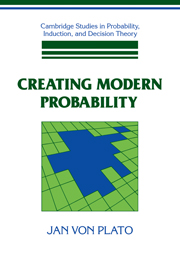Book contents
- Frontmatter
- Contents
- Preface
- 1 Introduction
- 2 Pathways to modern probability
- 3 Probability in statistical physics
- 4 Quantum mechanical probability and indeterminism
- 5 Classical embeddings of probability and chance
- 6 Von Mises' frequentist probabilities
- 7 Kolmogorov's measure theoretic probabilities
- 8 De Finetti's subjective probabilities
- Supplement: Nicole Oresme and the ergodicity of rotations
- Bibliography
- Index of Names
- Index of Subjects
2 - Pathways to modern probability
Published online by Cambridge University Press: 05 June 2012
- Frontmatter
- Contents
- Preface
- 1 Introduction
- 2 Pathways to modern probability
- 3 Probability in statistical physics
- 4 Quantum mechanical probability and indeterminism
- 5 Classical embeddings of probability and chance
- 6 Von Mises' frequentist probabilities
- 7 Kolmogorov's measure theoretic probabilities
- 8 De Finetti's subjective probabilities
- Supplement: Nicole Oresme and the ergodicity of rotations
- Bibliography
- Index of Names
- Index of Subjects
Summary
FIRST STEPS IN MEASURE THEORETIC PROBABILITY. AXIOMATIZATION
Gyldér's problem in continued fractions
Measure theory originated at the end of the last century from problems encountered mainly in mathematical analysis, the theory of trigonometric series, and integration theory. Measure first was a generalization of geometric measure in Euclidean space. Current measure theory originated as an abstraction from making the concepts independent of real numbers and real spaces. This abstract kind of measure theory was first given in Fréchet (1915).
In Borel (1898) a generalization of length on the real line was proposed which is now called the Borel measure. The definition is repeated in Borel's first paper on probability (1905b): First measurable sets are defined as consisting of closed intervals, finite or denumerable unions of closed intervals, and complements relative to a given measurable set. The Borel measure of an interval [a, b] is b – a, that of a denumerable set of pairwise disjoint closed intervals the sum of the lengths of the intervals, and the measure of a complement E – F the measure of E minus that of F. If an arbitrary set E is contained in a measurable set A of measure α and contains a measurable set B of measure β, its measure m is less than or equal to α and greater than or equal to β.
- Type
- Chapter
- Information
- Creating Modern ProbabilityIts Mathematics, Physics and Philosophy in Historical Perspective, pp. 27 - 70Publisher: Cambridge University PressPrint publication year: 1994

